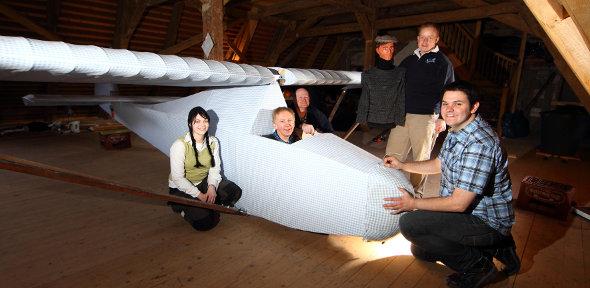
Colditz Castle, one of the most notorious prisoner of war camps in Nazi Germany, was supposed to be escape-proof. But in the dark days at the end of World War II, a group of British officers dreamt up the most audacious escape plan in history.
I love ideas that put visual spectacle and real engineering challenge centre stage - and that's certainly what Windfall films and Dr Hugh Hunt are doing here.
Channel 4 Commissioning Editor for History Julia Harrington
In a secret workshop in an attic in the castle they constructed a two-man glider out of bed sheets and floorboards. They were going to fly to freedom from the roof of the castle, but the war ended before they could put their plan into action, so no one knows if it would have worked.
Now the Brits return to Colditz to finish the job for a Channel 4 TV documentary. Cambridge engineer Dr Hugh Hunt leads a crack team of aeronautics engineers and carpenters to rebuild the glider in the same attic using the same materials. Then he attempts to do something the prisoners never got a chance to try: use a bathtub full of concrete to catapult the glider off the roof of the castle.
This 90-minute film is about the most audacious plan ever devised to escape from a prison camp. In 1945, two British prisoners-of-war were to be catapulted from the roof of notorious Colditz Castle in a homemade glider, fly it to a meadow 180 metres below, where they would continue their escape on foot. The "Colditz Cock", as the glider was called, represents an incredible feat of aeronautical engineering - particularly since it had to be built in secret in a tiny attic using homemade tools and improvised materials like bed boards, sleeping bags, gramophone springs and porridge!
Unfortunately, the war ended before the Cock ever had the chance to stretch its wings and no one knows if the crazy idea would have actually worked...until now. Led by Cambridge engineer extraordinaire Dr Hugh Hunt (also seen in Dambusters: Building the Bouncing Bomb and Digging the Great Escape), a team of daredevil engineers attempt to rebuild the glider in the very same loft in Colditz, using similar materials to the wartime POWs and comparable homemade tools. Luckily, our modern day escapers are able to follow in the footsteps of their intrepid forebears. Quite a bit is already known about the glider and how it was built; there are the original plans and there is even a snapshot of it.
However, once they've finished building the plane, the team will take an almighty leap into the unknown. Precious little information remains about how the Colditz Cock was to be launched from the roof. Officials from the State of Saxony who own the castle granted Windfall Films permission to restage the glider launch from the roof of Colditz to find out whether the plan would have ever actually worked. Somehow, the team have to construct a runway 20 metres above ground on the apex of a roof, and contrive a launching mechanism which will dispatch their glider efficiently and silently into the air. It's hardly surprising the feat has never been attempted before.
Hugh goes behind the legend, and finds out what it was really like for the men imprisoned here, and the families waiting for them back home. Along the way, archeologists open up some of the castle's other famous escape routes.
Dr Hugh Hunt has a compelling personal reason for taking part in the project. His beloved uncle William "Andy" Anderson was imprisoned in the castle from 1941-1945. Andy, a celebrated Colditz face, was a leading forger, running a secret production line that conjured up convincing German documents for would-be escapers. Hugh knows very little about his uncle's time in Colditz, and the film follows him as he learns about Andy Anderson's inventive genius in the face of adversity, and challenges Hugh to recreate some of his uncle's wartime improvisations.

